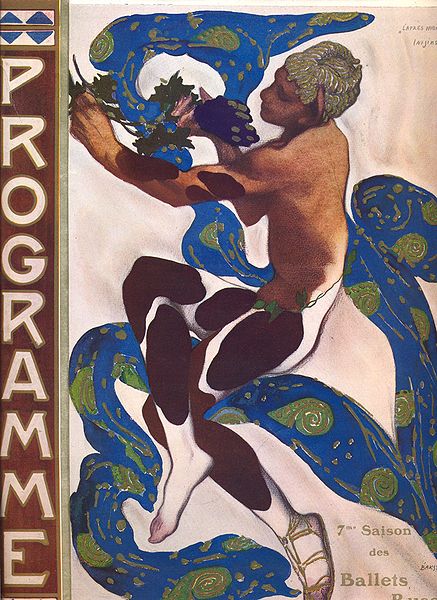by Lauren Warnecke, MS
In 2010, Alastair Macaulay seriously pissed me off.
His gross review of NYCB’s Sugar Plum Fairy and her Cavalier, and specifically his comment on their waist sizes, sent shockwaves through the interwebs. I wouldn’t say that he’s necessarily done it again, but there’s a little buzz beginning on the social media about his new editorial on naked dancing.

I’m hardly shocked that Macaulay’s first paragraph, and most of the essay, are comparing modern experimental dance to porn and strippers. To be honest, I fully expected to be writing another rant about sensationalism in dance writing….. but I have to say, I’m aligned with Mr. Macaulay on a couple of points.
Dancing in the buff has serious implications that you can’t avoid (no matter how much we want them to). It’s an artistic choice that instantly personalizes dancers and makes them into real people, with legs and hips and – other parts. Depending on the degree of naked, your costume (or lack thereof) also creates the distinct persona of sexual beings, and if that’s what you want, then go for it.
But…
Naked is not a decision you should make lightly as a dancemaker, or, in my opinion, frequently. That’s not because I don’t want to see naked people; it’s because the one thing that you think is so extreme and unique and impactful is actually quite overdone. It’s sort of like making a dance to Barber’s Adagio. Like it or not, most audience members are going to have preconceived notions about nudity. Maybe you can prep them in program notes and pre-show talks to depersonalize the dance and see the beauty of the human form in motion, or maybe you’re okay with the influence of the giggling twelve-year-old boy in all of us seeping into the overall impact you want your piece to have. If not, find another way.
I’m not frustrated by nudity in dance because I find it offensive. Rather, I’m put off by the fact that the choreographer couldn’t find another way to represent vulnerability, or truth, or love, or whatever. Getting naked isn’t as extreme as you might think… I’ve used it (more than once), along with almost every dancemaker in my acquaintance.
My point is: Go ahead! Get naked if you have to, but recognize that there will always be that guy giggling in the back comparing your art to a strip club. Just, whatever you do, please don’t make a naked dance to Barber’s Adagio…

Contributor Lauren Warnecke, M.S., is a Chicago-based dance artist, educator, and writer. She trained at the Barat Conservatory of Dance before earning a BA in Dance at Columbia College Chicago. In 2009, Lauren completed her MS in Kinesiology at the University of Illinois at Chicago, with a concentration in Motor Control and Learning. Lauren is a Visiting Instructor for the department of Kinesiology and Nutrition at UIC, and teaches master classes and seminars in ballet, modern dance, creative movement, and dance pedegogy. She is certified in ballet by the Cecchetti Council of America and a member of the American College of Sports Medicine.
In addition to teaching at UIC, Lauren owns and operates Art Intercepts, under which she creates, informs, and writes about dance. The primary mission of Art Intercepts is to bridge the gap between the scientific and artistic communities to present programming that is informed, inventive, and evidence-based. Lauren is a freelance writer/blogger and maintains monthly columns at Danceadvantage.net and 4dancers.org. and was featured on a panel of nationally reputed dance writers at the 2012 Dance/USA conference. She also works periodically as a grant writer and production/stage manager for artists in the Chicago dance and performance community, and volunteers for initiatives encouraging Chicagoans to engage in local, sustainable, and active lifestyles. Lauren likes to hike, bake scones, and dig in the dirt.





Catherine, you made some great points in your response to nakedness in dance. However, I believe that there is an even deeper conversation that should be had, specifically with Macaulay’s reference to ‘nakedness’ in ballet. In my response to Macaulay’s editorial in my own blog,I briefly outline the value of the naked body in dance in a historical, social and cultural context. Firstly, nakedness has alot to do with the rejection of hegemony and the blending of gender roles in our society. As we have moved from monarchy, monotheism and segratarianism to democracy, universalism and multiculturalism, we have also lost the need to ‘protect’ our bodies from others with clothes. Clothes defined us, our genders, our cultures, our status. We don’t have to maintain our separateness anymore. Secondly, we have come to embrace and marvel at the athletic ‘real’ body rather than the ideal body. This ‘push’ towards accepting ourselves is also seen in pop culture with celebrities tweeting photoshop free photos and appearing makeup free in magazines and on talk shows. Thirdly, and this is particularly true for ballet, nakedness is a way of freeing dance from its classical heritage. Going sans costume frees the dancing body from the constraints of costuming and allows for an expansion of the classical movement vocabulary. In other word, our changing philosophical views affect the aesthetic form in dance. This has to happen for dance to remain art.
Hi Samantha–thanks for the comment and for sharing your thoughts here. (Just a quick FYI for clarification…my columnist, Lauren, wrote the piece–it’s not mine)
Interesting perspective, and you raise some good points. I agree with many of them, but am not sure I’m on board with the statement “we have come to embrace and marvel at the athletic ‘real’ body rather than the ideal body”. I do think we have made progress in this regard, but I think we still have a long way to go, and am not certain that the majority of people are actually “on board” with that idea. I do think that the push is going in that direction though, and I believe it is a good thing!
Thanks again for ringing in on this!